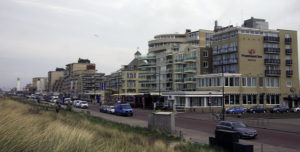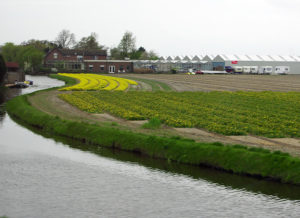After an early arrival at Amsterdam airport we had several hours before boarding Rex Rheni. Saga had arranged for a trip to Noordwijk, a sea side town on the North Sea which is popular with tourists in the summer months. It has a long sandy beach which on a cold, dull day in March was decidedly bracing. Behind it are sand dunes.
In the C15th this was a fishing village with a fleet of nearly 40 boats which left from the beach as there was no harbour. In the C19th it became popular with the rich as a holiday resort. Sea water was believed to have a beneficial cleansing effect. The impressive Grand Hotel Huis ter Duin was built. With the combination of long sandy beaches and the colourful bulb fields, it became the ‘floral seaside resort of Europe’. The arrival of the steam tram opened the area up to the holiday masses. It is still a popular holiday resort and the sea front is lined with large modern tourist hotels and cafes. At the far end is the tall square white lighthouse built nearly a hundred years ago.
There is a pleasant modern shopping centre with a good range of shop. I was particularly taken with the cheese shop with its brightly wrapped cheeses.
The C19th brick built church, De Buurtkerk, at the end of Hoofdstraad was firmly locked.
Besides its beaches, Noordwijk is also known for its bulb flower fields. Bulbs have been grown in the area since the end of the C19th. It is located in an area called the “Dune and Bulb Region. The majority of bulb fields lie behind the dunes as the sandy soil there is extremely suitable for cultivation. Daffodils, hyacinths and tulips are grown here.















